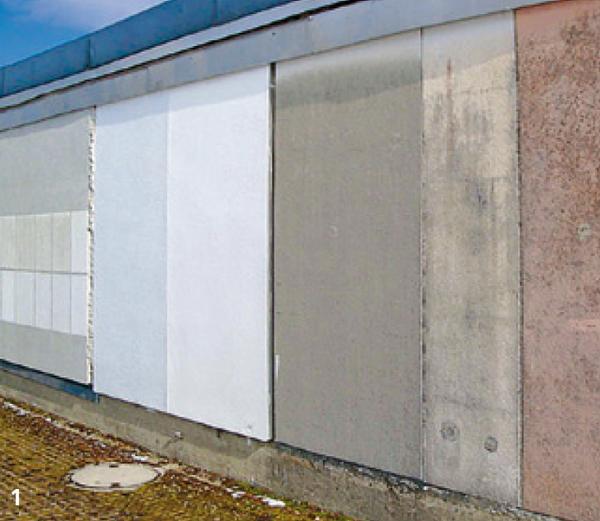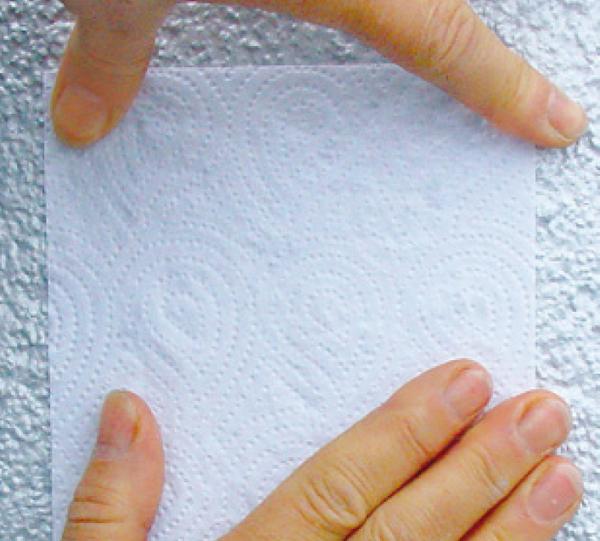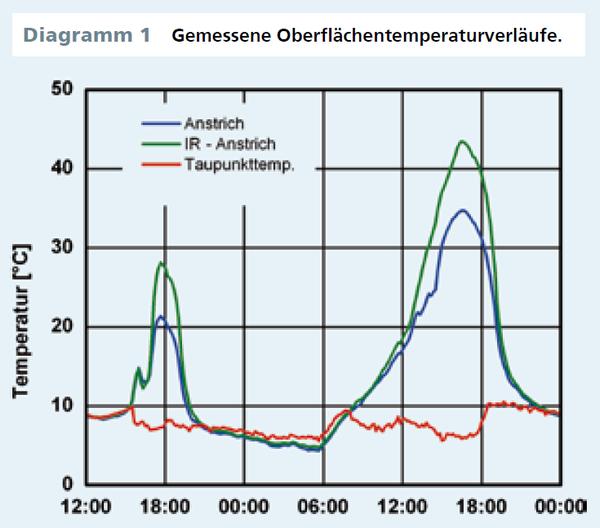A very promising way of reducing condensation buildup on the façades is to use IR (infrared) paint. By adding special pigments, scientists were able to modify the paints in such a way that the emissivity of long-wave radiation was reduced from over 90 percent to below 60 percent in some cases. At Fraunhofer IBP’s outdoor testing facility, scientists conducted tests on composite thermal insulation systems painted with IR paint (Figure 1).
Each type of paint is characterized by determining its radiation values. The degree of short-wave radiation absorption describes the proportion of incident sunlight absorbed by a surface in the wavelength range of 250 to 2500 nm (ultraviolet, visible, near infrared). The higher the degree of absorption, the more the surface heats up. The lower the surface's emissivity, the less long-wave thermal radiation is exchanged with the surrounding environment during the day and night. This means that the surface remains warmer during the day and does not cool down as much during the night. Long-wave emissivity is determined by measuring spectral reflectance in the wavelength range between 2.5 and 50 nm using a Fourier interferometer (emission level = 1 - reflectance).
Test surfaces coated with both paints were measured and analyzed. The paints were applied to existing composite thermal insulation systems consisting of 240 mm sand-lime brickwork and 80 mm mineral-wool insulation. Temperature sensors built into the outer layers of plaster measured the surface temperature. To determine the amount of water adhering to the surface, cellulose pads cut to a specific size were first weighed when completely dry, then applied to the façade and pressed firmly onto its surface. Reweighing the pads allowed the scientists to determine the amount of moisture on the surface. Drying time can be determined by repeatedly blotting the surface - Figure 2 shows this being carried out on a wall surface.
The IR paint under examination was shown to have an absorption level of 0.20 and an emissivity of 0.65, while the comparative paint sample was found to have an absorption level of 0.16 and an emissivity of 0.88. In conjunction with climate data collected at IBP’s own weather station, the readings showing the fluctuation in surface temperature were used to calculate the times during which the façade was covered with condensation. By comparing the amount of time (in hours) during which temperatures dropped below the dew point over the course of the one-year test period, the IR paint was found to reduce these condensation periods by up to 13 percent. The difference is even more obvious if the amount of time below the dew point is weighted by kelvins per hour. Over the course of the year, this equates to a 28-percent reduction using IR paint.
The diagram shows the fluctuations in surface temperature over time for both paints in relation to the dew point for a specific period of time. The surface temperature of the IR paint is significantly higher than that of any conventional paint during both the day and night. Surface moisture levels were measured several times during the testing period. While the surface coated with the control paint repeatedly yielded between 10 and 25 g/m² of condensation collected by blotting, the surface coated with IR paint remained dry. At no point in time was any condensation collected from the IR paint by blotting.
The tests showed that applying paint with reduced emissivity significantly reduces the time period in which condensation forms on the surface of the façade. Scientists were able to prove this by measuring surface temperatures and surface moisture levels at their outdoor testing facility.
Computational tests indicated that the length of time during which temperatures drop below the dew point is some 15 percent lower on the south and east sides of a building than on the north and west sides. Since there was hardly any microbial growth on these two sides, it is logical to assume that reducing the condensation period on the surface of a façade by 15 percent is an effective way of preventing microbial growth.


